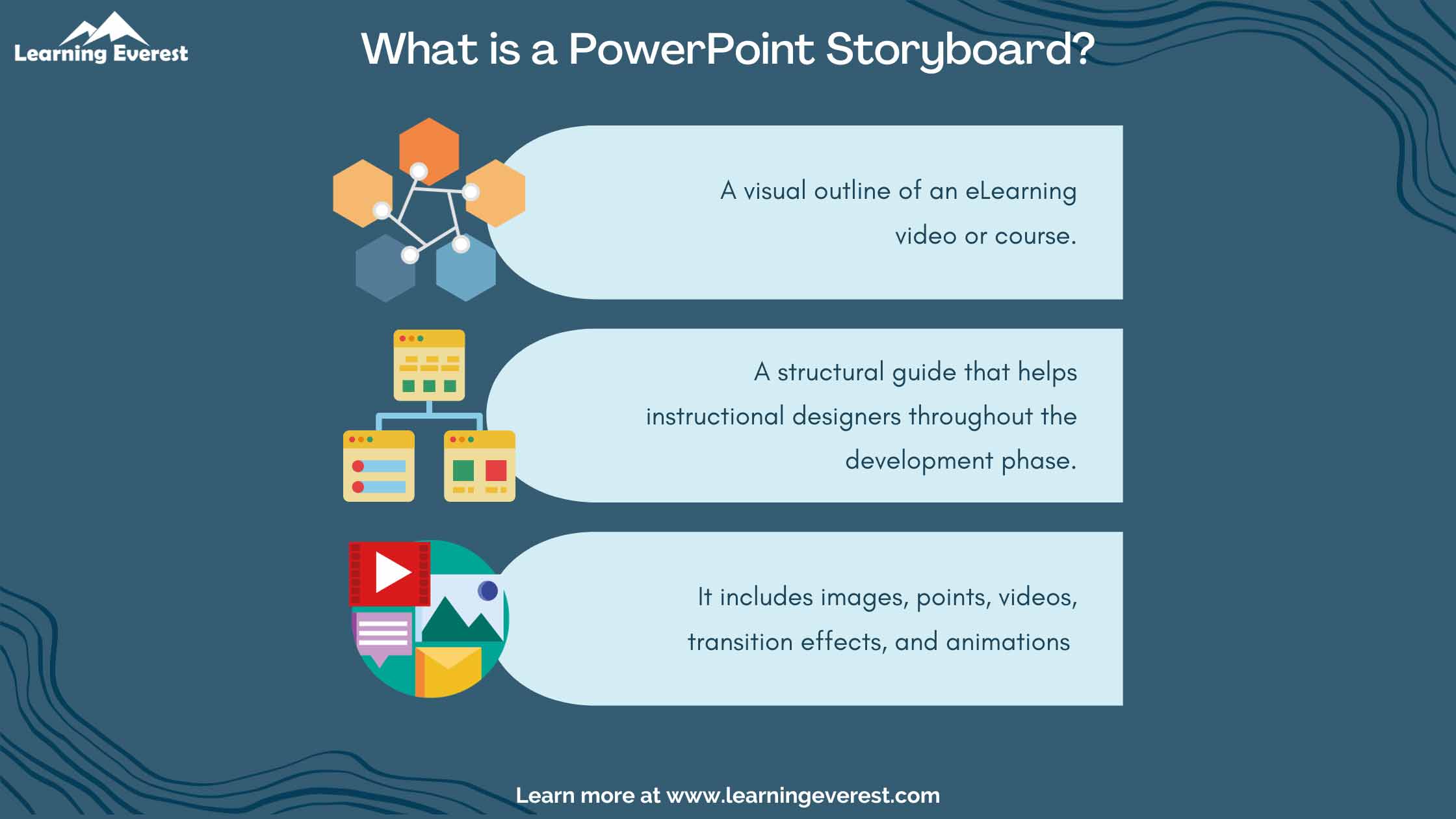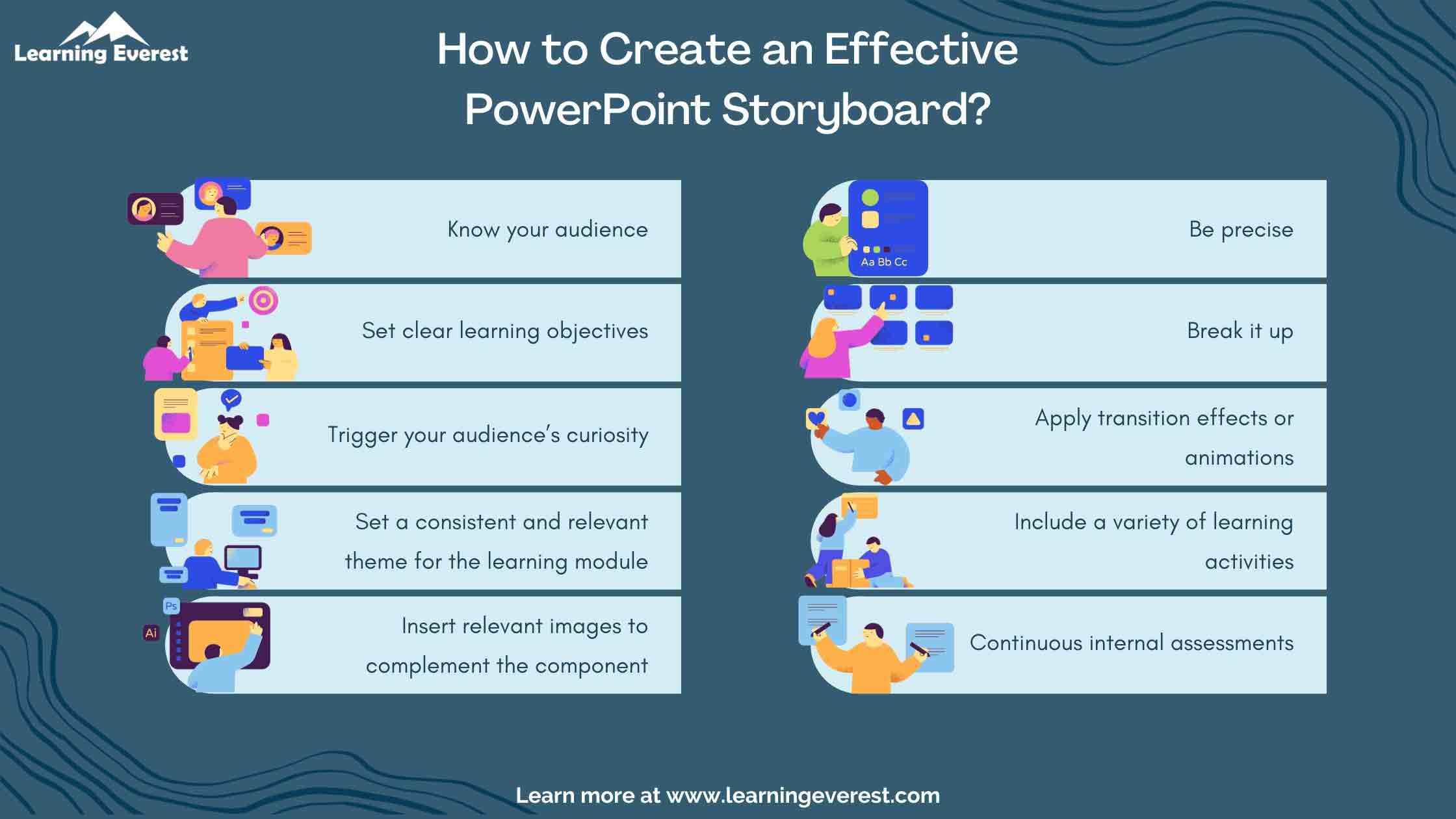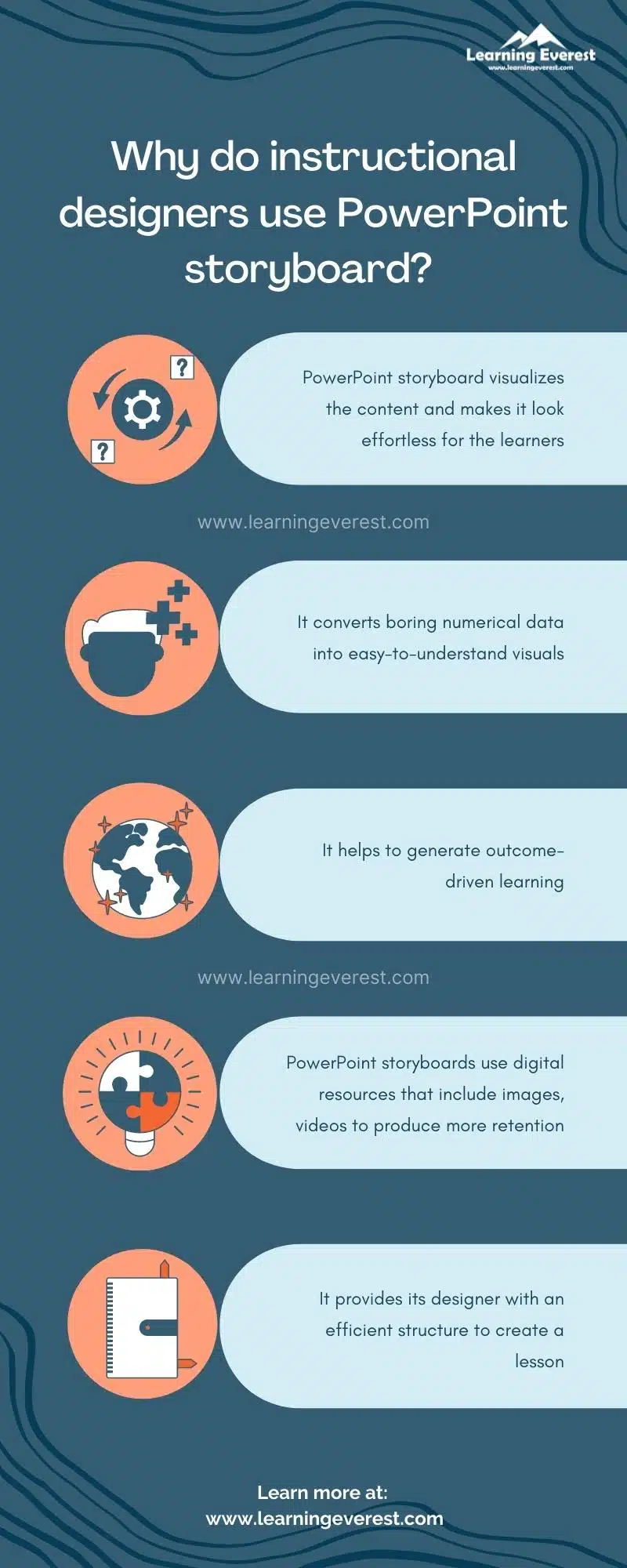Learning a new skill or technology can be enjoyable if taught sufficiently. In our current modern situation, we have many opportunities where we get to benefit from learning quickly and easily using e-learning technologies, where the learning not only depends upon a skilled instructor but also upon a well-crafted learning module. Therefore, creating an effective e-learning design for the learners is very important.
Table of Contents
- What is a PowerPoint storyboard?
- Why do instructional designers use PowerPoint storyboard?
- How to create an effective PowerPoint storyboard?
- Infographics
- Knowledge Check!
- Conclusion
- Frequently Asked Questions (FAQs)
- What is a PowerPoint storyboard?
- What is a storyboard?
- Why is using a storyboard so helpful?
- How do you storyboard efficiently?
When creating an online course, the primary goal remains the same regardless of who the audience is. It is to make the learning as easy as possible for its audience to understand. E-learning provides opportunities for learners for self-directed learning. Instructional designers design and evaluate interactive e-learning modules for learners with the aim of active participation on the part of the learners. But it is not that easy. To maintain the effectiveness of the course, e-learning professionals use PowerPoint storyboards to generate an efficient e-learning module for the learners. But what is a PowerPoint storyboard? How can we create an effective PowerPoint storyboard for the learners? This article will discuss the benefits of a PowerPoint storyboard in developing e-learning courses.
What is a PowerPoint storyboard?

What is a PowerPoint Storyboard
A PowerPoint storyboard is a visual outline of a video or an eLearning course. PowerPoint storyboard includes images, points, videos, transition effects, and animations to create a visual representation of content. It is a structural guide that helps the instructional designers throughout the course of the development phase. The instructional designer or training developer outlines the structure of the e-learning course they intend to construct in PowerPoint slides. Using PowerPoint slides, they create a storyboard that narrates the course module as a story. It provides them an opportunity to demonstrate their ideas while providing an enriching e-learning experience to its learners.
Why do instructional designers use PowerPoint storyboard?
Storyboards can help instructional designers, content developers, and other creative professionals to organize their thoughts and arrange events. With this function in PowerPoint, developers can plan, visualize, and develop products such as motion pictures. There are many benefits of using a storyboard to create e-learning courses. Storyboards ensure that the delivery of the content is easily understandable to its audience. A PowerPoint storyboard is beneficial,
- To engage its learners more: Engaging learning content that is aesthetically appealing and visual designs are excellent approaches to get the learners’ attention and attract their interest. When it comes to learning, visual effects have a high-fidelity rate. Storyboarding in e-learning does an exceptional job at keeping the learners engaged throughout the learning journey with its use of visual content. PowerPoint storyboard visualizes the content and makes it look effortless for the learners.
- To convert boring numerical data into easy-to-understand visuals: Instead of creating PowerPoint slides full of information and numerical data, storyboards provide the learners with pictures and illustrations that show a sequence of content.
- To generate outcome-driven learning: The learning objectives can be effectively achieved using PowerPoint storyboarding. It has proven to be more effective for learners. A PowerPoint storyboard is more likely to produce successful results than conventional learning approaches. The learners using eLearning courses, develop extraordinary cognitive abilities than traditional learners, as storyboards create a unique experience throughout the learning process. Therefore, the learners exhibit better problem-solving skills, excellent memory, higher attention, and better retention.
- To produce more retention: PowerPoint storyboards use digital resources that include images, videos, and audio. Therefore, learners get to retain more than any traditional learning method.
- To have a proper structure: PowerPoint storyboard provides its designer with an efficient structure upon which they can create a lesson. It maintains the learning journey.
How to create an effective PowerPoint storyboard?

How to Create an Effective PowerPoint Storyboard
Okay, now, in order to effectively create a PowerPoint storyboard that can properly visualize the e-learning module, we must acknowledge a few things.
- Know your audience: First and foremost, understanding who you are developing it for gives the e-learning module developers a clear picture. An e-learning course should always be learner-oriented. Therefore, designers must be aware of their audience while creating an effective storyboard.
- Set clear learning objectives: It is essential to have a clear idea of what are the desired outcomes of the course. Why are you creating the course in the first place? It is very important to identify what the learners need to know from the course. Having a clear picture of the learning objective gives a proper structure to the course in general and helps the trainers choose the best module to train their learners/ employees.
- Trigger your audience’s curiosity: It is important to generate a sense of interest in the learners so that they continue with the course. Curiosity drives us to learn more. Therefore, e-learning designers need to maintain the level of interest among their learners. By asking relevant questions and evaluating the course, the designers can motivate the learners throughout the course.
- Set a consistent and relevant theme for the learning module: Creating consistency throughout the learning journey is essential. Using slide master, designers can set a consistent theme coordinating with the branding guidelines. It provides a visually aesthetic learning experience to the learners.
- Insert relevant images to complement the component: As discussed before, visual contents have high retention power. In order to hold the maximum attention, instructional designers must include relevant visual details in their content, such as images, data charts, and videos. It makes the e-learning module highly interactive with a high-fidelity rate.
- Be precise: Endless content is the fastest way to disengage the learners – no one, especially those who lead hectic lives, has an endless supply of time and patience to dedicate to their learning. Therefore, instructional designers should be precise with the content they need to deliver.
- Break it up: Instructional designers should not design extended modules. Breaking up the lesson into pieces and delivering short lessons allow learners to learn independently at their own pace. E-learning should always be flexible in nature. Therefore, while creating a PowerPoint storyboard, instructional designers should have this in mind.
- Apply transition effects or animation: Use transition effects or animations to add variety to the storyboard. It helps to generate curiosity as well as holds the learners’ attention.
- Include a variety of learning activities: At the beginning of each lesson, tell the learners a fascinating fact. To get learners to participate in the learning session, begin with a warm-up activity. Introducing a variety of learning activities will help them to hold their attention more, and as a result, they will learn more.
- Continuous internal assessments: It is important to evaluate the learning journey in every step. It not only considers the learners’ progress but also evaluates the efficiency of the e-learning course in general. Therefore, while creating a PowerPoint storyboard, instructional designers must allow the learners to evaluate every now and then during the course.
Infographics
Knowledge Check!
Conclusion
In our modern times, e-learning has a remarkable potential to shape the future and assist learners in attaining some of the most crucial and unachieved objectives. An effective PowerPoint storyboard can help in achieving these objectives. A well-crafted storyboard can make sure that the learner receives the same quantity of knowledge that is required. Therefore, it also helps in changing workforce training. It lets the employees upskill their job at a faster rate and creates significant opportunities for their economic mobility. It also leverages the organizations to achieve their goals.
Frequently Asked Questions (FAQs)
What is a PowerPoint storyboard?
A PowerPoint storyboard is a visual outline of a video or an eLearning course. The PowerPoint storyboard includes images, points, videos, transition effects, and animations to create a visual representation of content.
What is a storyboard?
A storyboard is an outline of a video or an eLearning course.
Why is using a storyboard so helpful?
A well-crafted PowerPoint storyboard can make sure that the learner receives the same quantity of knowledge that is required.
How do you storyboard efficiently?
The instructional designer or training developer outlines the structure of the e-learning course they intend to construct in PowerPoint slides. Using PowerPoint slides, they create a storyboard that narrates the course module as a story. It provides them an opportunity to demonstrate their ideas while providing an enriching e-learning experience to its learners.






